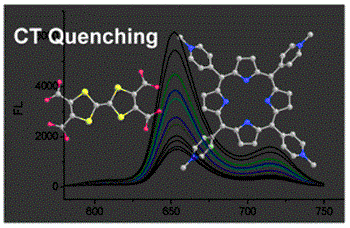Li-Jun Xue, Peng Huo, Yan-Hong Li, Jin-Le Hou, Qin-Yu Zhu* (朱琴玉)and Jie Dai*(戴洁)
College of Chemistry, Chemical Engineering and Materials Science, Soochow University
Phys. Chem. Chem. Phys., 2016,18, 2940-2948
Great progress has been made in combining a TTF moiety with a porphyrin unit by covalent bonds, but only a few examples were reported in which TTF and porphyrin assembled by noncovalent interactions. In contrast to the energy- and time-consuming synthetic procedures for the covalent system, the assembly of a non-covalent ionic system would be a cost-effective way to construct donor–acceptor ensembles. Herein a new type of ionic TTF–porphyrin dyad is obtained. A methylated tetra(4-pyridyl) porphyrin (5,10,15,20-tetrakis-(N-methyl-4-pyridyl)-porphyrin, TMPyP) is selected as the cation, and TTF-bicarboxylate (L1) or TTF-tetracarboxylate (L2) is used as the anion. Crystal structures of two TTF-TMPyP ionic D–A compounds, TMPyP-(HL1)4·3H2O (1) and TMPyP-(H2L2)2·5H2O (2), were characterized by single-crystal X-ray diffraction. The strong ionic interaction enhances the charge-transfer between the regular mixed-stacking donors and acceptors, which are investigated comprehensively by spectral, electrochemical and theoretical studies. The variation in properties between L1 and L2 is of great advantage to understand the influence factors for charge-transfer. The charge-transfer properties can be modulated not only by the nature of the donor or the acceptor, but also the cation–anion ratio in the salt, which shows great flexibility of the D–A ionic dyad in the design and preparation of new charge-transfer systems.

链接://pubs.rsc.org/en/Content/ArticleLanding/2016/CP/C5CP06141E#!divAbstract